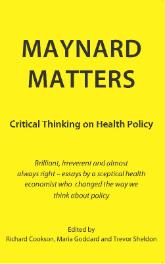OECD is preparing the annual meeting for next Tuesday, and this week has released a report on what to do with waste in health expenditures. Recognising that we have a problem is the first step to define a solution. The report shows the reasons, the categories of waste and the policy and management approaches. The agenda for health policy makers is getting larger. Highly recommended reading for this weekend.
Four main reasons can explain why individual actors might contribute to wasting resources:In my opinion this report has extremely useful hints for policy makers, and should be in their toolkit.
● First, they do not know better: cognitive biases, knowledge deficits, risk aversion and habits lead to suboptimal decisions and errors and deviations from best practice.
● Second, they cannot do better: the system is poorly organised and managed and co-ordination is weak. In these first two situations, for the most part, actors do not intend to generate waste and are doing their best but the outcome is suboptimal
● Third, actors could stand to lose by doing the right thing; this occurs when economic incentives are misaligned with system goals – for instance, when clinicians are paid for providing services irrespective of whether the services add value.
● Fourth, all categories of actors might generate waste intentionally, with the sole purpose to serve their self-interest. This last driver is in fact a variation on the third (poor incentives) but it more explicitly points to fraud and corruption.
Three categories of waste:
● Wasteful clinical care covers instances when patients do not receive the right care. This includes preventable clinical adverse events, driven by errors, suboptimal decisions and organisational factors, notably poor co-ordination across providers. In addition, wasteful clinical care includes ineffective and inappropriate care – sometimes known as low-value care, mostly driven by suboptimal decisions and poor incentives. Last, wasteful clinical care includes the unnecessary duplication of services.
● Operational waste occurs when care could be produced using fewer resources within the system while maintaining the benefits. Examples include situations where lower prices could be obtained for the inputs purchased, where costly inputs are used instead of less expensive ones with no benefit to the patient, or where inputs are discarded without being used. This type of waste mostly involves managers and reflects poor organisation and co-ordination.
● Governance-related waste pertains to use of resources that do not directly contribute to patient care, either because they are meant to support the administration and management of the health care system and its various components, or because they are diverted from their intended purpose through fraud, abuse and corruption
Four categories of policy levers are relevant:
● Economic and financial incentives that seek to influence the behaviour of patients,
clinicians or managers; these are most relevant when poor incentives are the root cause
of the wasteful behaviour.
● Behaviour change policies and information support – including education, persuasion
and training – to address barriers to optimal decisions.
● Organisational changes, which include policies that modify the location, role, number,
co-ordination and tools available to accomplish specific tasks of various stakeholders.
● Regulations to mandate changes in behaviour, organisation or information.
Hergé-Tintin Exhibition au Grand Palais jusqu'a dimanche





